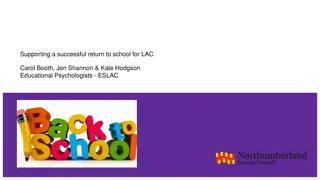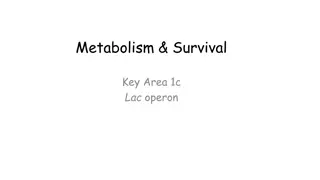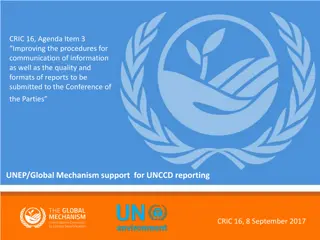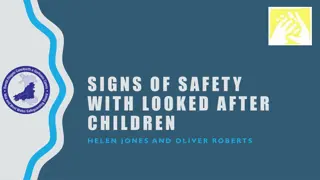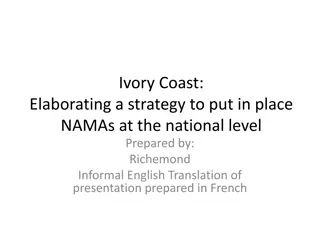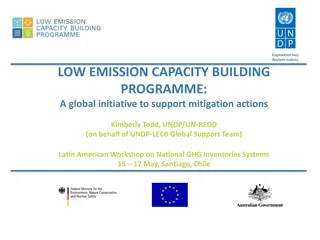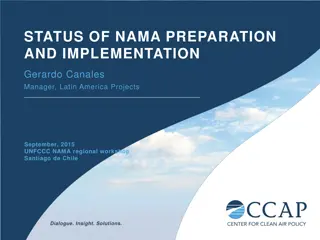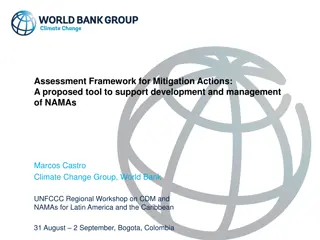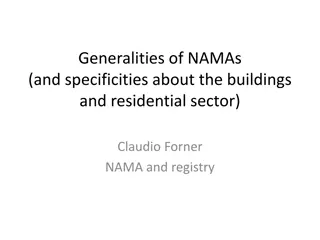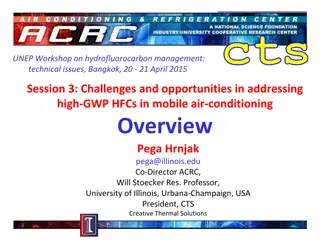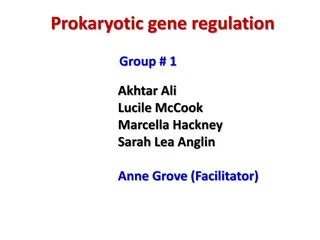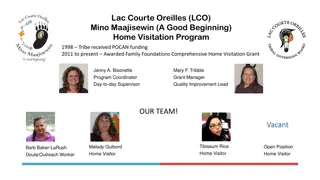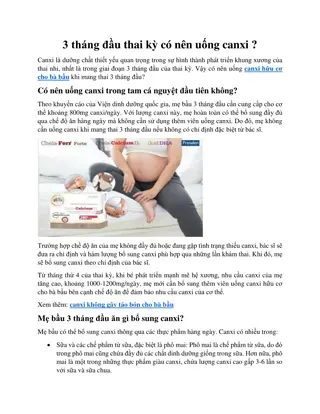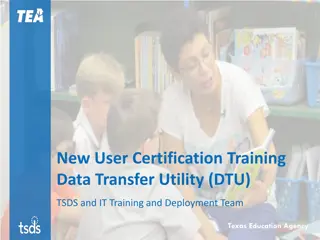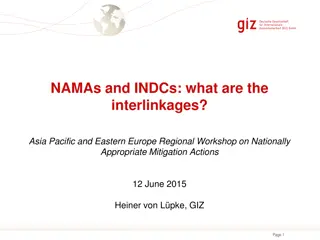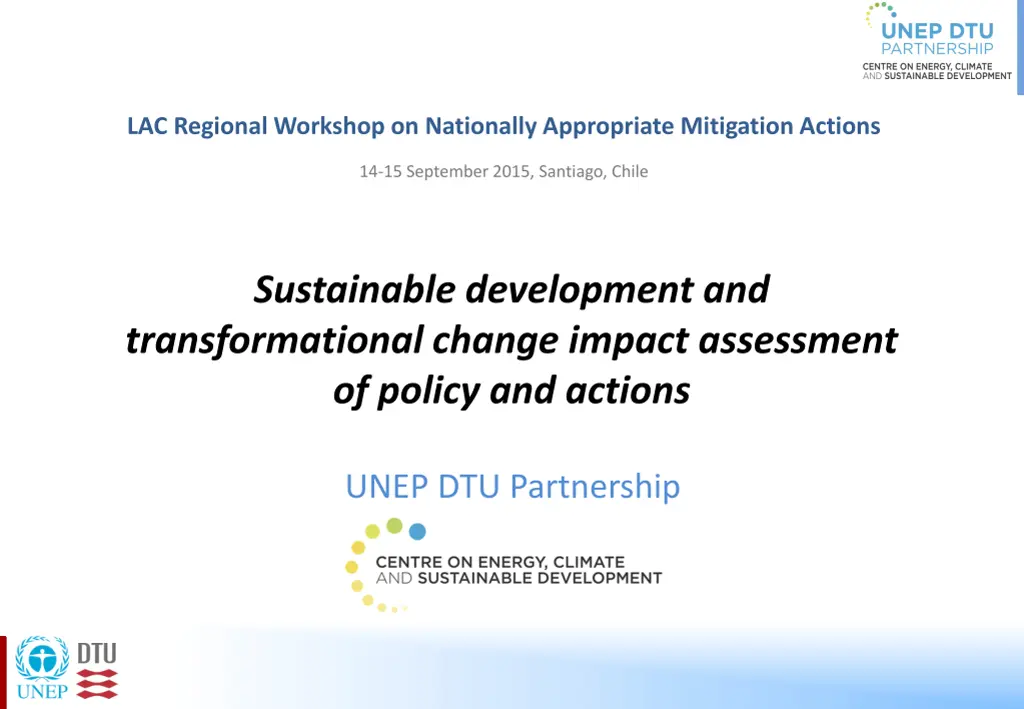
Mitigation Actions Workshop Impact Assessment and Transformational Change
Explore the outcomes of research projects focusing on Nationally Appropriate Mitigation Actions (NAMAs) and sustainable development in the LAC region. Learn about measuring sustainable development outcomes, stakeholder perspectives, and transformative change in NAMAs. Discover methodologies, tools, and case studies related to NAMAs and transformational change.
Download Presentation

Please find below an Image/Link to download the presentation.
The content on the website is provided AS IS for your information and personal use only. It may not be sold, licensed, or shared on other websites without obtaining consent from the author. If you encounter any issues during the download, it is possible that the publisher has removed the file from their server.
You are allowed to download the files provided on this website for personal or commercial use, subject to the condition that they are used lawfully. All files are the property of their respective owners.
The content on the website is provided AS IS for your information and personal use only. It may not be sold, licensed, or shared on other websites without obtaining consent from the author.
E N D
Presentation Transcript
LAC Regional Workshop on Nationally Appropriate Mitigation Actions 14-15 September 2015, Santiago, Chile Sustainable development and transformational change impact assessment of policy and actions UNEP DTU Partnership
Outline: Objectives of two research projects NAMA SD Framework NAMA SD tool example from the Philippines Understanding TC in NAMAs concept paper Case studies of TC TC Taxonomy towards a methodology
Objective of the Research Project Measuring SD in NAMAs , Phase 1 Aim: To improve quantitative and qualitative measurement of the SD outcomes of NAMAs - enhancing understanding of how NAMAs can contribute to meeting national development goals. Outcomes: Enhanced understanding of the expectations and needs of stakeholders in measuring SD in NAMAs; improved knowledge of early action and lessons learned on measurement of SD in NAMAs through an examination of tools, frameworks and indicators and of how these actions/tools meet the needs of various stakeholders. Outputs: Literature review, interviews, criteria for NAMA SD Framework, final report Website: www.namapartnership.org
Methods & data Literature review: Firstly, we reviewed previously applied tools to assess and measure SD impacts of diverse efforts such as sectoral strategy development, climate change strategy, product lifecycle assessment and project development, to help identify recommendations for approaches to assess SD benefits of NAMAs. Key components of the literature review include: 1) Review of SD tools in general 2) Review of climate change SD tools Stakeholder interviews: Secondly, to understand the different stakeholder perspectives of developing country governments, donors, private sector and civil society on the needs to measure SD in NAMAs a survey was send to a broad group of NAMA stakeholders. The survey has been circulated to 2056 people in September 2014. The response rate is 16,4 % with 338 answers to the survey. Eight in-depth interviews were conducted with 2 developing country government perspectives, 2 NGO perspectives, 2 private sector perspectives and 2 donor perspectives.
TC in NAMAs Objective: To improve the understanding of transformational change (TC) and how to Monitor, Report and Verify (MRV) Nationally Appropriate Mitigation Actions (NAMAs) that may facilitate TC for low emission and sustainable development to achieve the 2 C target Phases and outputs: Phase 1: Understanding transformational change Output 1: Conceptual paper Output 2: Case studies Phase 2: Methodological framework (on-going work) Output 3: NAMA TC taxonomy Output 4: Test of tool to 93 NAMAs submitted to UNFCCC Registry by 1 May 2015
Guiding principles Not prescriptive focus on what to do, not how to do it, e.g. definitions of sustainable vs. unsustainable are nationally determined Transparent all assessments whether qualitative, quantitative or monetary shall be publicly available for review at any Consistent - indicator based to deliver comparable and structured information about SD co-benefits and negative impacts for all NAMAs across all sectors Credible independent review shall ensure that methods are valid and results are reliable Stakeholder participation is a right and facilitates good climate governance Easy to use - the framework should not require much extra effort than is currently practiced for M&E of development outcomes unless required for particular needs to sustainable development
NAMA Sustainable Development Taxonomy Social Environmental Institutional Economic Capacity Building Policy & Planning Growth Energy Air Land Jobs Health & Safety Balance of Payment Natural Resources Domestic MRV System Laws & Regulation Technology Welfare Water Education Growth Investment Industrial/commercial activities Economic growth/higher income Quality of life Increased tax base Infrastructure Production cost Productivity Other Energy Coverage/availability of supply Access Reliability, affordability Other Technology Imported technology Local technology Adaptation and viability in local area Other Balance of payments Dependency on foreign sources of energy Amount of energy produced from clean renewable sources Decrease in risk of political conflicts Economic savings for the government Reduction in energy subsidies Other Capacity Building Land titling processes Mapping of natural resources and renewable energy potential Development of competitive procedures Workshops and trainings A technical help desk for project developers and other stakeholders Other Policy & Planning Policy Framework for Sustainable, Low carbon Urban Transport Comprehensive Urban Low carbon Mobility Plans Other Domestic MRV System Sub national reference levels and MRV systems Platform for the Generation and Trading of Forest Carbon Credits Other Laws & Regulation Tariff reform Compliance with laws and regulation on Promoting and regulating production, sale and use of biofuels and biomass Decrees for tax benefits for renewable energy projects Conditions for competitive process for incorporation of new plants Other Air Jobs Long term jobs Short term jobs Sources of income Other Health and Safety Accidents Crime Diseases Number of hospital visits Sanitation Food safety Indoor air pollution No child labour Other Education Green development related training Educational services for different groups Project related knowledge circulation Other Welfare Traffic congestion Commuting times Income/asset distribution Women empowerment Municipal revenue Rural upliftment Energy security Other SOx, NOx, GHG Odor, Dust, SPM, Fly ash Noise Land Compost Manure nutrient and other fertilizer Soil erosion, Salinization, Acidification Minimum tillage End of life pollution Change access/lost access to land Other Water Waste water Leaks & diesel dumping Drinking water quality Water extraction rate Conservation Supply, water access Ecological state Purification Other Natural Resources Minerals Species diversity Plant life Land cover change Other
SD assessment framework in the NAMA Cycle SD Assessment Actors NAMA cycle Ex-ante Assessment Design of NAMA & Support Program NAMA Developer & Partners SD Criteria & Indicators Transformational change National Coordination National Coordinating Body Quantification & Monetization International Support Agencies Means of Support Procedural Steps TT Finance CS Alignment with SD goals Registry Public Participation National / UNFCCC Registry International National No-Harm Safeguards Ex-post Assessment National Stakeholders Implementation of NAMA Monitoring & Reporting Independent Review Certification National & Independent Entities MRV
Steps Element Description 1. SD criteria & indicators Identify and describe SD impacts using the CDM SD taxonomy with one new dimension Assessment Ex-Ante 2. Transformational change Indicators of the processes of change for a paradigm shift to low carbon and sustainable development 3. Quantification & Monetization Units of measurement to track SD impacts towards SD goals are identified and methods to estimate their monetary value are applied 4. Alignment with SD goals SD impact analysis and contribution to SD goals at global, national, and other relevant levels Procedural steps 5. Stakeholder Participation Guidelines for stakeholder involvement throughout NAMA design and implementation 6. No-Harm Safeguards Compliance with no-harm safeguards to avoid or mitigate negative impacts 7. Monitoring & Reporting Develop a monitoring plan; How are indicators monitored, by whom, how often? Describe quality assurance procedures. Report the monitoring data to relevant stakeholders at regular intervals. Ex-post Assessment 8. Verification Independent review of methods and data shall be provided when needed to ensure SD impacts are credible and transparent 9. Certification Public, private or civil society players may want to define standards for certification of units of GHG reductions with SD impacts
NAMA SD Tool - the case of the Philippines
Relevance to SDGs and Targets Selected (Yes/No) Effect on Indicator Monitoring done (Yes/No) Indicator Identified Impacts Explanation of Chosen Indicator Domain Air pollution/quality Goal 11, Target 11.6 Goal 6, Target 6.6 Goal 11, Target 11.6 Goal 12, Target 12.4 Goal 2, Target 2.4 Goal 11, Target 11.6 Goal 12, Target 12.4 Goal 11, Target 11.6 Goal 14, All Targets Goal 15, All Targets Positive Yes Environment Water pollution/quality Yes Increased water savings AWD leads to sognificant water savings as a result of improved irrigation Positive No AWD involves periodic aeration of the soil which results in higher zinc availability, as well as increased plant root anchorage and lodging resistance. Soil pollution/quality Others (Noise/visibility) Biodiversity and ecosystem balance Yes Improved soil quality Positive No Health Goal 3, All Targets Water savings from the implementation of AWD results in increased total irrigated land area. As a result, more farmers and farm helpers are required, providing additional livelihood for the poor farming communities; Because of the availability of more irrigation water for downstream farmers due to AWD, irrigation conflicts between upstream-downstream farming communities are decreased. Provide livelihood for poor/poverty alleviation. Decrease conflicts among farmers Goal 1, All Targets Goal 2, Target 2.1 Goal 16, Target 16.1 Goal 7, Targets 7.1 Goal 6, Tagets 6.1, 6.2, 6.4, 6.5 Goal 2, All Targets Goal 12, Target 12.3 Goal 8, Targets 8.2, 8.3, 8.5, 8.6, 8.7, 8.8 Livelihood of poor, poverty alleviation, peace Affordability of electricity Access to sanitation and clean drinking water Food security (Access to land and sustainable agriculture) Yes Positive No Increase in rice production. Increase in irrigated land Water savings from the implementation of AWD results in increased total irrigated land area. Proportionately, increase in total number of rice fields results in the increase in rice yield. Social Yes Positive Yes Quality of employment Time savings/time availability due to project No child labour Goal 1 Goal 8, Target 8.6 AWD is a water management practice in rice cultivation promoting the efficient use of water resources. This provides vulnerable groups access to water resources and services which were not previously available to them, resulting in increased total irrigated land area. Provides vulnerable groups access to local resources and services Goal 6, Targets 6.4, 6.5, 6.6, 6.a, 6.b Increase access to water resources Yes Positive Yes
Serial number Indicator Name Domain Parameter Name Baseline Value Unit Way of monitoring 1 #REF! Social Rice Production 18,032,525 t How Frequency By whom 18,702,349 Obtained from national rice statistics values 3 years NAMA Implementer Project Value QA/QC procedures QC check done NAMA Implementer Serial number Indicator Name Domain Parameter Name Baseline Value Unit Way of monitoring 4 #REF! Growth and Development Number of IAs and individual farmers to whom additional services have been provided 0 ha How Frequency By whom 750,000 Obtained from national rice statistics values 3 years NAMA Implementer Project Value QA/QC procedures QC check done NAMA Implementer
Parameter Unit Pre-Project Project Intervention value monitored Intervention value monitored Baseline value 18,032,525 4,690,061 Year1 Year2 Year3 tons ha ha Persons /ha/season Percentage ha 1 2 3 4 5 6 7 8 9 10 11 12 13 14 Rice Production Harvested Land Area Additional Services Trainings ISF cost 0 0 2,000 ISF collection percentage Area over which alternative cropping is practiced 70 0
Aim and content of the conceptual paper The aim of the paper is threefold: o To provide first and general insights into the meaning of Transformational Change o To compile a number of theoretical approaches that could be used for assessment of transformational impacts o To develop theses to guide the case studies Starting point: Defining transformational change through NAMAs Transformational Change through NAMAs is a change 1. that disrupts established high-carbon pathways, contributes to sustainable development and sustains the impacts of the change (goal dimension), 2. that is triggered by interventions of actorswho innovate low carbon development models and actions, connect the innovation to day-to-day practice of economies and societies, and convince other actors to apply the innovation to actively influence the multi-level system to adopt the innovation process, (process dimension) 3. that overcomes persistent barriers toward the innovated low carbon development model and/or create new barriers which hinder the transformed system to relapse into the former state ( low- carbon lock-in ).
Elements of transformational NAMAs Vision Transformational change starts with an ambitious vision of change. Experimentation and Innovation Transformational change involves risky decisions and investments that are not guaranteed to pay off. Governments can create the protected niches needed to experiment with new solutions. Actors and Coalitions Transformational change needs actors of change : innovators, disseminators, advocates, policy-makers.
Theses: Further aspects for NAMAs Instruments for Barrier Removal TC-NAMAs overcome persistent barriers. TC-NAMAs need policy instruments that are tailor-made to circumstance, in order to create a mix of push by markets and pull by policy. Systemic Change Transformational change needs to strike a balance between depth of change and connectivity to established practice (and habits) within society. For Transformational change, a portfolio of interventions is needed that together aim at change in all societal dimensions.
Transformational NAMAs: Layers of Change Systemic Change Instruments for Barrier Removal Actors and Coalitions Experiment- ation and Innovation Vision
Aim and selection criteria for case studies The aim of the case studies is twofold: o To share experience and detailed accounts of success stories of transformational change o To inform the development of a methodological framework for assessment of transformational change potential in NAMAs based on the sustainability transition theories to learn, what are the empirically based indicators and success factors. Selection criteria: o The case studies are focused on successful (as to-date), planned, and country specific interventions with a view to achieve low carbon development o A balance in the choice between developed and developing country cases o The choice of cases must have a clear link to the hypothesized success factors/theoretical approaches selected o Countries with the most ambitious GHG reduction goals will be selected o Maximize the diversity of sectors (including one tackling LULUCF and one tackling transport) o The amount of cases studies will be kept at a maximum of five
Five case studies on TC Developed country perspectives: Germany: Energy system transformation - the role of laws and regulatory frameworks for renewable energy Denmark: The role of wind power towards 100% renewable energy in electricity production by 2050 Developing country perspectives: Brazil: The drivers of deforestation - a 75% drop over a decade (2005-2014) Columbia: Sustainable transport in Bogot the role of political will & technical solutions at city level South Africa: The role of state-owned companies to lead an incremental transition away from high-carbon lock-in to a low-carbon future
Taxonomy for assessment of TC potential Dimensions Factors Indicators - based on questions to the cases What are the goal(s) and key indicator(s) of transformational change? Phases of transformation at what stage is the socio-technical system? Pre-development phase What are the established high-carbon pathways? Who are the pioneers of change? Operational definition of transformationa l change for low-carbon and SD Goal(s) of transformation Take-off phase What new ideas, concepts, coalitions, regulations and societal acceptance are emerging for low- carbon development? Process of change What intervention(s) trigger the change process? Who are the key actors? How will the intervention lead to system change? Acceleration phase How does policy and regulation support change? How does low-carbon solutions challenge established pathways? Is opposition to new solutions increasing or decreasing? Low-carbon lock-in Which barriers are overcome? How will a low-carbon pathway be sustained? Stabilisation phase Is the low-carbon pathway stable or at risk of relapse? What new barriers hinder relapse? Multilevel context for the socio-technical system transformed Landscape level What macro-level trends and changes in the socio-technical system have an impact on the transformation? Management of transformational change interventions a cyclic process of four governance activities Strategic How is the transition arena set up as the institutional core of an intervention in collaboration with a network of innovators? Regime level How is the socio-technical regime delineated? What established infrastructure and ways of doing things need to be changed with regard to rules, institutions, practices, behaviour, markets and industry structure? Tactical What are the driving sustainability and low carbon visions, agendas and pathways? How are actors mobilized for executing projects and experiments? Operational Niche level What new technologies or policies will trigger the transformational change? Do protected spaces exist for technical, social and organisational experiments and learning? Reflexive How does monitoring and evaluation of the transition process facilitate reflexive learning to modify and adjust transition goals and pathways? Interactions across levels What are the key dynamics of change between the three levels?
Next steps for development Discuss usefulness of the TC Taxonomy in stakeholder workshop with users (GCF, NAMA Facility and bilateral donors) Apply the TC Taxonomy to NAMAs under implementation (for more rich data) for development of Version 2, refinement of indicators Phase 3: Develop a scoring approach to weigh the criteria and indicators considered most important for TC


